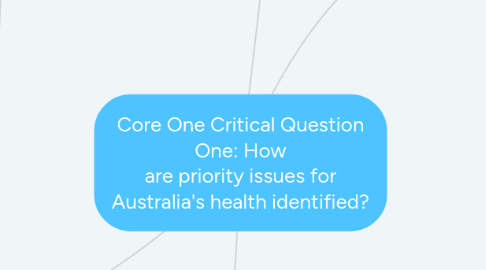
1. How changing certain aspects of life such as lifestyle and behavior to better our health, such as stopping smoking or going to a mammogram. this is also the switch from curative to preventative.
2. Identifying Priority Health Issues
2.1. Priority Population Groups
2.1.1. Population groups that experience health inequities need to be considered by health need to be considered by health authorities when determining health policy.
2.1.2. For CVD
2.1.2.1. ATSI
2.1.2.2. Low SES
2.1.2.3. Rural Residents
2.1.2.4. Migrant Groups
2.1.2.5. Those with a Family History
2.1.3. For Mental Health
2.1.3.1. Children/Young People
2.1.3.2. Over 65
2.1.3.3. Post - Trauma
2.1.3.4. Carers/ Children of Sufferers
2.1.3.5. Women Who have Given Birth
2.1.3.6. People Aged Between 14 - 30
2.1.3.7. Males Aged 15 - 34 and Over 65
2.1.4. For Cancer
2.1.4.1. ATSI
2.1.4.2. Low SES
2.1.4.3. Rural Residents
2.1.4.4. Certain Migrant Groups
2.1.5. For Injury
2.1.5.1. ATSI
2.1.5.2. Low SES
2.1.5.3. Rural Residents
2.1.5.4. Males
2.1.5.5. Over 65
2.1.6. For Asthma
2.1.6.1. Young Children
2.1.6.2. Over 55
2.1.7. For Diabetes
2.1.7.1. ATSI
2.1.7.2. Low SES
2.1.7.3. Rural Residents
2.1.7.4. Males
2.2. Handy Men
3. identifying priority health issues
3.1. Prevalence of Condition
3.1.1. How common a condition is in a community and highlights points of difference for the same condition so the government can better allocate resources.
3.2. Potential for Prevention and Early Intervention
3.3. Cost to the Individual and Community
3.3.1. Individual
3.3.1.1. Impact on physical, social, emotional health of people varies.
3.3.1.2. Cost either direct - can be measured- such as treatment or lost working hours.
3.3.1.3. Pain/Relationship Breakdown/Depression/ Decreased Quality of Life.
3.3.2. Community
3.3.2.1. Annual cost for diagnosis, treatment, care of sick over $30 billion.
3.3.2.2. Indirect cost not included: loss of income/travel costs.
3.3.2.3. GPD - 8%. Fear of increase due to : Aging population/ more informed population/ increased Medicare use/ Advances in tech.
3.4. Social Justice Principles
3.4.1. Social justice is when the rights of all members of the community are considered in a n equitable manner.
3.4.2. Supportive Environments
3.4.2.1. Offer people protection from factors that can threaten good health. EG NO SMOKING AREAS
3.4.3. Equity
3.4.3.1. Fair allocation of resources and entitlements without discrimination. EG. MEDICARE/ PBS
3.4.4. Diversity
3.4.4.1. Compromises the differences among individuals among individuals/ groups of individuals.
4. Measuring health status
4.1. Epidemiology
4.1.1. Is the study of a disease in a population group.
4.1.2. We learn the needs and health status of a population and where resources should be allocated.
4.1.3. Doctors, hospitals, governments and health professionals all use epidemiology.
4.1.4. Does not take into account a persons quality of life.
4.2. Measures of Epidemiology
4.2.1. Mortality
4.2.1.1. The number of deaths in a group of people from a disease over a period of time, used to compare health status across groups between years.
4.2.2. Infant Mortality
4.2.2.1. The rate is the number of infant deaths in the first year of life per 1000 live births.
4.2.3. Morbidity
4.2.3.1. Refers to patterns of illness, disease and injury that do not result in death in a given population.
4.2.4. Life Expectancy
4.2.4.1. Is the length of time a person can expect to. More specifically, it refers to the average number of years of life remaining to a person of a particular age.
